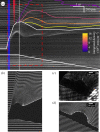Whole-beam self-focusing in fusion-relevant plasma
- PMID: 33280566
- PMCID: PMC7741010
- DOI: 10.1098/rsta.2020.0159
Whole-beam self-focusing in fusion-relevant plasma
Abstract
Fast ignition inertial confinement fusion requires the production of a low-density channel in plasma with density scale-lengths of several hundred microns. The channel assists in the propagation of an ultra-intense laser pulse used to generate fast electrons which form a hot spot on the side of pre-compressed fusion fuel. We present a systematic characterization of an expanding laser-produced plasma using optical interferometry, benchmarked against three-dimensional hydrodynamic simulations. Magnetic fields associated with channel formation are probed using proton radiography, and compared to magnetic field structures generated in full-scale particle-in-cell simulations. We present observations of long-lived, straight channels produced by the Habara-Kodama-Tanaka whole-beam self-focusing mechanism, overcoming a critical barrier on the path to realizing fast ignition. This article is part of a discussion meeting issue 'Prospects for high gain inertial fusion energy (part 2)'.
Keywords: fast ignition; inertial confinement fusion; laser–plasma interactions; plasma channelling; proton radiography; synthetic diagnostics.
Conflict of interest statement
We declare we have no competing interests.
Figures










References
-
- Shalloo RJ. et al. 2019. Low-density hydrodynamic optical-field-ionized plasma channels generated with an axicon lens. Phys. Rev. Accel. Beams 22, 041302 (10.1103/PhysRevAccelBeams.22.041302) - DOI
-
- Lemos N. et al. 2019. X-ray sources using a picosecond laser driven plasma accelerator. Phys. Plasmas 26, 083110 (10.1063/1.5091798) - DOI
-
- Ceurvorst L. et al. 2016. Mitigating the hosing instability in relativistic laser–plasma interactions. New J. Phys. 18, 053023 (10.1088/1367-2630/18/5/053023) - DOI
-
- Matsuoka T. et al. 2008. Focus optimization of relativistic self-focusing for anomalous laser penetration into overdense plasmas (super-penetration). Plasma Phys. Controlled Fusion 50, 105011 (10.1088/0741-3335/50/10/105011) - DOI
LinkOut - more resources
Full Text Sources
